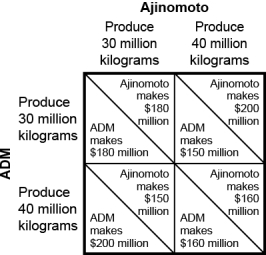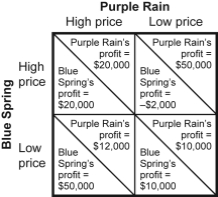A) high;high
B) low;low
C) high;low
D) low;high
Correct Answer

verified
Correct Answer
verified
Multiple Choice
Use the following to answer questions :
Figure: Payoff Matrix for Ajinomoto and ADM  -(Figure: Payoff Matrix for Ajinomoto and ADM) Use Figure: Payoff Matrix for Ajinomoto and ADM.The optimal combination for maximum combined profit occurs when ADM produces _____ million kilograms and Ajinomoto produces _____ million kilograms.
-(Figure: Payoff Matrix for Ajinomoto and ADM) Use Figure: Payoff Matrix for Ajinomoto and ADM.The optimal combination for maximum combined profit occurs when ADM produces _____ million kilograms and Ajinomoto produces _____ million kilograms.
A) 30;30
B) 40;40
C) 30;40
D) 40;30
Correct Answer

verified
Correct Answer
verified
Multiple Choice
Use the following to answer questions :
Scenario: Payoff Matrix for Firms X and Y
The following payoff matrix depicts the profits for the only two firms in this oligopolistic industry.  -(Scenario: Payoff Matrix for Firms X and Y) Payoff Matrix for Firms X and Y.If firm X were to choose its dominant strategy,it would:
-(Scenario: Payoff Matrix for Firms X and Y) Payoff Matrix for Firms X and Y.If firm X were to choose its dominant strategy,it would:
A) choose a low price.
B) choose a high price.
C) encounter a dilemma since there are two dominant strategies.
D) allow firm Y to dominate the industry.
Correct Answer

verified
Correct Answer
verified
True/False
Oligopoly firms that produce only cement are less likely to collude than firms in a cell phone oligopoly.
Correct Answer

verified
Correct Answer
verified
Multiple Choice
Antitrust policy refers to government:
A) attempts to prevent the acquisition of monopoly power.
B) attempts to encourage the exercise of monopoly power.
C) encouragement of collusion in the marketplace.
D) attempts to limit private enterprise.
Correct Answer

verified
Correct Answer
verified
True/False
A trust is a government agency that enforces laws limiting the power of oligopolies.
Correct Answer

verified
Correct Answer
verified
Multiple Choice
Use the following to answer questions : -(Table: Demand for Solar Water Heaters) Use Table: Demand for Solar Water Heaters.The marginal cost of producing solar water heaters is zero,and only two firms,Rheem and Calefi,produce them.Suppose they agree to produce only 25 water heaters each.If Rheem cheats on the agreement and produces 30 water heaters,what is the quantity effect for Rheem?
A) $1 000
B) $4 500
C) $2 000
D) $9 000
Correct Answer

verified
Correct Answer
verified
Multiple Choice
Gary's Gas and Frank's Fuel are the only two providers of gasoline in their town.Gary and Frank decide to form a cartel.Later,Gary summarizes his pricing strategy as,"I'll cheat on the cartel because,regardless of what Frank does,cheating gives me the best payoff." This is an example of:
A) a dominant strategy.
B) a tit-for-tat strategy.
C) an irrational strategy.
D) product differentiation.
Correct Answer

verified
Correct Answer
verified
Multiple Choice
Use the following to answer questions : -(Table: Demand for Crude Oil) Use Table: Demand for Crude Oil.Assume that the crude oil industry is a duopoly and the marginal cost of producing crude oil is zero.Suppose that the two firms are maximizing industry profit and splitting the profit evenly.If firm 1 decides to cheat and increase production by 10 more barrels,the price of crude oil will be:
A) $0.
B) $70.
C) $80.
D) $160.
Correct Answer

verified
Correct Answer
verified
True/False
If Air Canada offers free drinks and snacks on its flights and West Jet follows,they are engaging in non-price competition.
Correct Answer

verified
Correct Answer
verified
Multiple Choice
One framework used to analyze strategic choices is:
A) the tacit supply curve model.
B) game theory.
C) perfect competition.
D) risk assessment.
Correct Answer

verified
Correct Answer
verified
Multiple Choice
A strategy in which players cooperate initially but then mimic what the other players do is referred to as a:
A) prisoners' dilemma.
B) tit-for-tat strategy.
C) price leadership model.
D) kinked demand curve model.
Correct Answer

verified
Correct Answer
verified
Multiple Choice
Which statement does NOT describe OPEC?
A) OPEC is the Organization of Petroleum Exporting Countries.
B) OPEC is an international cartel made up of 12 oil-producing countries and two unofficial members.
C) OPEC is the cartel that was responsible for the large increases in crude oil prices in the 1970s.
D) OPEC is the name of the free-trade zone encompassing the Middle East and other oil-producing nations.
Correct Answer

verified
Correct Answer
verified
Multiple Choice
Use the following to answer question 92:
Figure: Payoff Matrix I for Blue Spring and Purple Rain  -(Figure: Payoff Matrix I for Blue Spring and Purple Rain) Use Figure: Payoff Matrix I for Blue Spring and Purple Rain.The figure refers to two producers of bottled water.Each has two strategies available to it: a high price and a low price.The dominant strategy for Purple Rain is to:
-(Figure: Payoff Matrix I for Blue Spring and Purple Rain) Use Figure: Payoff Matrix I for Blue Spring and Purple Rain.The figure refers to two producers of bottled water.Each has two strategies available to it: a high price and a low price.The dominant strategy for Purple Rain is to:
A) charge a low price.
B) charge a high price.
C) adopt the same strategy as Blue Spring.
D) Purple Rain does not have a dominant strategy.
Correct Answer

verified
Correct Answer
verified
True/False
An attempt by a firm to convince buyers that its product is different from the products of other firms in the industry is an example of cooperative behaviour.
Correct Answer

verified
Correct Answer
verified
Multiple Choice
A customer with significant buying power in an industry would:
A) make a tacit price agreement more difficult to achieve.
B) make a tacit price agreement easier to achieve.
C) have no effect on tacit pricing agreement negotiations.
D) result in a kinked demand curve.
Correct Answer

verified
Correct Answer
verified
True/False
The breakup of Microsoft in 2005 was one of the first applications of antitrust policy in the United States.
Correct Answer

verified
Correct Answer
verified
Multiple Choice
Both monopolists and cartel members will find that a drop in price leads to:
A) a quantity effect that reduces total revenue.
B) a price effect that reduces total revenue.
C) a quantity effect that has no effect on total revenue.
D) neither a price nor a quantity effect.
Correct Answer

verified
Correct Answer
verified
Multiple Choice
OPEC is a(n) _____ cartel that includes _____ national governments.
A) illegal;12
B) legal;12
C) illegal;11
D) legal;8
Correct Answer

verified
Correct Answer
verified
True/False
Oligopoly first became an issue in Canada in the second half of the nineteenth century,when the growth of railroads allowed for a national market for goods.
Correct Answer

verified
Correct Answer
verified
Showing 61 - 80 of 272
Related Exams